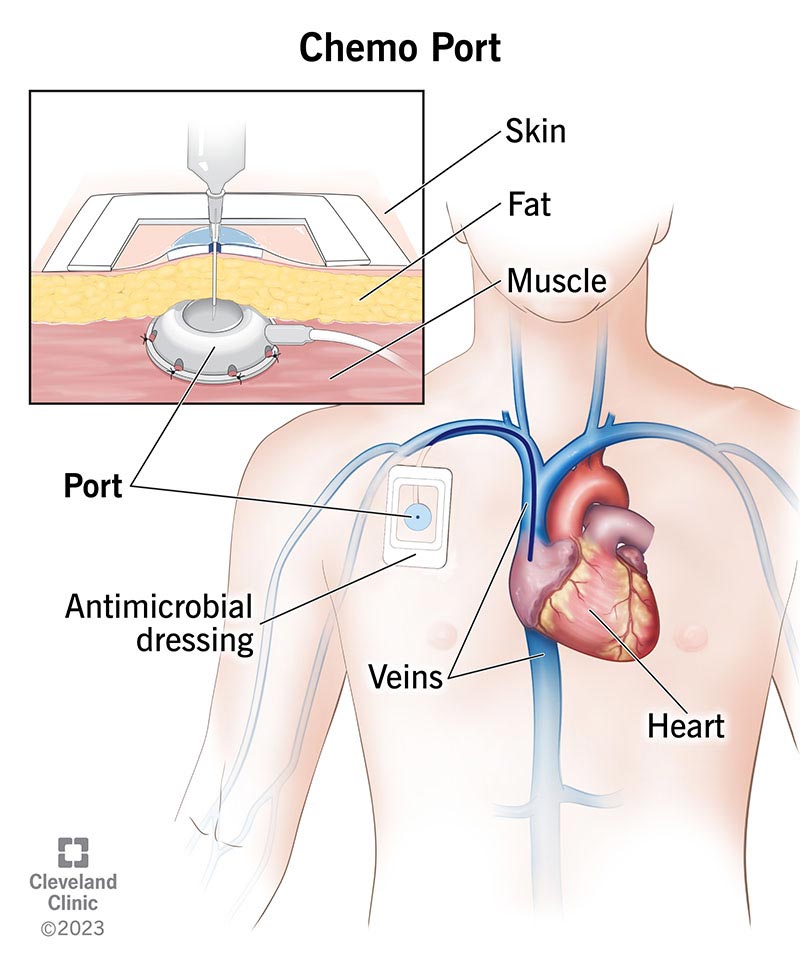A chemo port is a small, implantable device that attaches to a vein (usually in your upper chest area). It allows healthcare providers to draw blood and give treatments — including chemotherapy drugs — without a needle stick. A port can remain in place for weeks, months or even years.
Advertisement
Cleveland Clinic is a non-profit academic medical center. Advertising on our site helps support our mission. We do not endorse non-Cleveland Clinic products or services. Policy

A chemo port (chemotherapy port) is a small, implantable device — about the size of a U.S. quarter. It goes under your skin (in your upper chest, arm or abdomen), and a thin silicone tube connects the device to a vein.
Advertisement
Cleveland Clinic is a non-profit academic medical center. Advertising on our site helps support our mission. We do not endorse non-Cleveland Clinic products or services. Policy
Lots of people need ports for medical care, especially those undergoing cancer treatments. These devices reduce the number of needle sticks necessary for blood draws, infusions and injections. A port can help make chemotherapy safer and just a little more comfortable.
Another name for an implanted port is “port-a-cath.”
Chemo ports can be circular, triangular or oval-shaped, depending on the brand of port your surgeon places. There are three main parts to a chemo port:
There are also two types of chemo ports:
Once your chemo port is in place, healthcare providers can use it to draw blood or deliver fluids and medications. To do this, they’ll insert a needle through your skin and into your port’s septum (the rubbery center).
Chemo port placement requires surgery. The procedure usually takes about an hour. You’ll be able to go home on the same day. But you should have a trusted friend or family member drive you to and from your appointment.
Advertisement
During the procedure, your medical team will:
Your surgeon will use continuous X-ray imaging (fluoroscopy) to guide the procedure. They’ll also take a chest X-ray to ensure your chemo port is in the correct spot.
A chemo port has many advantages, including:
Because chemo port placement is a surgical procedure, there are certain risks, including:
After chemo port placement, most people have mild pain or soreness around their incisions for the first couple of days.
You can resume most normal activities right away. But ask your provider before hitting the gym. Too much strenuous activity can displace your chemo port.
A chemo port can stay in as long as you need it — even several years. Your surgeon can remove your port when you don’t need it anymore.
Chemo port removal involves making a small incision over the port. Your surgeon will free the port from any surrounding tissue and remove the entire device at once. Then, they’ll close the incision with stitches.
Advertisement
You may develop mild discomfort, swelling and bruising after chemo port removal. These side effects are normal and should fade in a few days.
You should call your healthcare provider right away if you have a chemo port and develop:
If you have a chemo port, the most ideal sleeping position is on your back. Sleeping on your back places minimal pressure on your port. Avoid sleeping on your stomach, especially during the recovery period. This could put pressure on your port and lead to increased soreness.
You can also sleep on your side. If your chemo port is on the right side of your chest, try sleeping on your left side — or vice versa.
There’s really no sleep position that’s dangerous for someone with a chemo port. But you should avoid positions that could place unnecessary pressure on your port — like sleeping with your arms raised above your head.
You can begin chemotherapy as soon as your port is in place.
No, chemo port placement isn’t a major surgery. The necessary incision is usually about an inch long. In most cases, chemo port placement is an outpatient procedure, which means you can go home on the same day.
Advertisement
You might feel pressure or a slight pinch when your provider places a needle in your chemo port. But having a chemo port makes blood draws, infusions and injections much more tolerable compared to cancer treatment through a traditional intravenous (IV) line.
Yes, as long as your healthcare provider says it’s OK, you can shower 24 to 48 hours after your chemo port procedure. You’ll need to cover the surgical site with plastic wrap so it doesn’t get wet.
Once you’ve healed from your procedure, you can shower, bathe or even swim with your chemo port.
A chemotherapy port, or chemo port, is a small, implantable device. It delivers chemotherapy drugs directly to your bloodstream through a vein in your chest, arm or abdomen. Healthcare providers can also use your port to draw blood and give you fluids. Having a chemo port can greatly reduce the number of needle sticks required at your oncology appointments — and in many cases, it can make cancer treatments safer. Talk to your oncologist to find out if a chemo port is right for you.
Advertisement
When you’re diagnosed with cancer, you want expert and compassionate care right away. At Cleveland Clinic we personalize your treatment to match your needs.

Last reviewed on 01/31/2023.
Learn more about the Health Library and our editorial process.